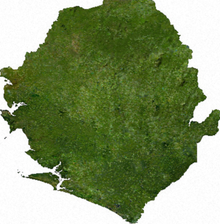Ebola virus epidemic in Sierra Leone

Map of Sierra Leone
|
|

Cropped satellite view of S. Leone
|
|
| Disease | Ebola virus |
|---|---|
| Deaths | 3,955 |
| Confirmed cases | 14,061 (as of 25 October 2015[update]) |
An Ebola virus epidemic in Sierra Leone occurred in 2014, along with the neighbouring countries of Guinea and Liberia. On March 18, 2014 Guinean health officials announce the outbreak of a mysterious hemorrhagic fever "which strikes like lightning." It was identified as Ebola virus disease and spread to Sierra Leone by May 2014. The disease is thought to have originated when a child in a bat-hunting family contracted the disease in Guinea in December 2013. Consumption of African bushmeat, including rats, bats, and monkeys, is commonplace in Sierra Leone and West Africa in general.
At the time it was discovered, it was thought that Ebola virus is not endemic to Sierra Leone or to the West Africa region and this epidemic represents the first time the virus has been discovered there. However, some samples taken for Lassa fever testing turned out to be Ebola virus disease when re-tested for Ebola in 2014, showing that Ebola had been in Sierra Leone as early as 2006.
In 2014 it was discovered that samples of suspected Lassa fever showed evidence of the Zaire strain of Ebola virus in Sierra Leone as early as 2006. Prior to the current Zaire strain outbreak in 2014, Ebola had not really been seen in Sierra Leone, or even in West Africa among humans. It is suspected that fruit bats are natural carriers of disease, native to this region of Africa including Sierra Leone and also a popular food source for both humans and wildlife. The Gola forests in south-east Sierra Leone are a noted source of bushmeat.
Bats are known to be carriers of at least 90 different viruses that can make transition to a human host. However, the virus has different symptoms in humans. It takes one to ten viruses to infect a human but there can be millions in a drop of blood from someone very sick from the disease. Transmission is believed to be by contact with the blood and body fluids of those infected with the virus, as well as by handling raw bushmeat such as bats and monkeys, which are important sources of protein in West Africa. Infectious body fluids include blood, sweat, semen, breast milk, saliva, tears, feces, urine, vaginal secretions, vomit, and diarrhea.
Even after a successful recovery from an Ebola infection, semen may contain the virus for at least two months. Breast milk may contain the virus for two weeks after recovery, and transmission of the disease to a consumer of the breast milk may be possible. By October 2014 it was suspected that handling a piece of contaminated paper may be enough to contract the disease. Contamination on paper makes it harder to keep records in Ebola clinics, as data about patients written on paper that gets written down in a "hot" zone is hard to pass to a "safe" zone, because if there is any contamination it may bring Ebola into that area. (see also Fomites)
...
Wikipedia
